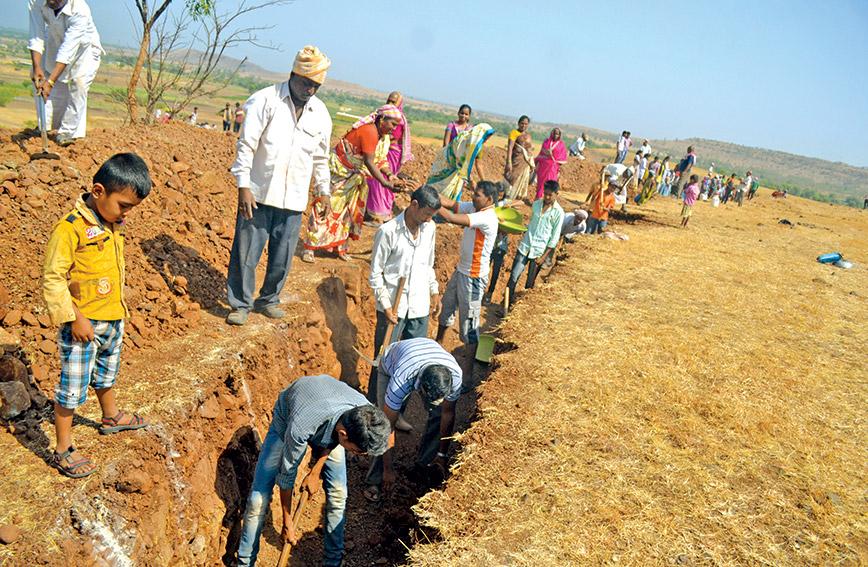
People responded enthusiastically to a call to do manual labour voluntarily and dig trenches for harvesting water
Winning the Water Cup in parched Maharashtra
Shree Padre, Satara
At sunrise every day, across 13 districts in Maharashtra, thousands of villagers set out to dig trenches and build earthen dams. This has been their early morning routine for the past 45 days. From able-bodied men and women to little boys in shorts and frail grandfathers, everybody chips in. There is no time to be lost because they are getting ready for the monsoon and the second round of the Satyamev Jayate Water Cup, which offers cash awards for villages in Maharashtra that drought-proof their settlements.
The cash awards are just an incentive. Water harvesting and watershed management come with serious benefits that transform the lives of farming communities which have been haunted by drought — often despite receiving some rain.
This year, parched villages hope to catch as much rain as possible and put it back into the earth — thereby reviving the water cycle that can sustain farming. It is a desperate effort by villagers to save themselves from the chronic drought which has wracked their lives.
The Satyamev Jayate Water Cup gives the top three villages Rs 50 lakh, Rs 30 lakh and Rs 20 lakh, respectively. There is also a prize for sustainability. Started two years ago by actor Aamir Khan and his wife, film producer Kiran Rao, the Paani Foundation has one ambitious objective — to drought-proof Maharashtra.
Dr Avinash Pol, a dentist, now popularly known as the ‘paanyache (water) doctor’, is the foundation’s inspiration and helps guide its policies and programmes. From the historic Ajinkyatara Fort, Dr Pol began a shramdaan or voluntary work initiative to restore water levels in Satara town and showed the difference this could make across the district (see Civil Society, August 2016).
For the Water Cup, villages are assessed on watershed management and water conservation works. Last year, 116 villages entered the competition. This year, as word spread, around 1,300 villages from 13 districts in Vidarbha, Marathawada and western Maharashtra are competing.
In 2016 Velu village won the Satyamev Jayate Water Cup. Before the monsoon broke the villagers had worked hard to drought-proof their village. Then, in June, it rained. Just 275 mm. It was enough for the village to say goodbye to water tankers. After 20 years.
The rabi crop was good too. Each of the 350 families in the village harvested five to eight quintals of grain, says Duryodhan Panduranga Nanavare, 63, one of Velu’s trainers who learnt to catch the rain from Paani Foundation last year.
Chief Minister Devendra Fadnavis, who gave away the prizes on Independence Day, added another Rs 20 lakh to the Rs 50 lakh that Velu village won. Another NGO put in an additional Rs 5 lakh.
“Eighty percent of the villages that participated in last year’s competition bid goodbye to the water tankers they had been dependent on for years,” says Dr Pol.
Last year, water harvesting and watershed management carried out across villages made it possible to save more than a billion litres of water, which would otherwise have arrived in 1.3 million tanker loads. And Rs 272 crore worth of water is now being annually conserved, according to estimates by the Paani Foundation.
It isn’t easy to get people to work together shoulder to shoulder and realise that the solution to their problem lies in their own hands. Social mobilisation is the lynchpin of success. But when the rains fail, crops fail and the only solution people can think of is to migrate to the city.
The strategy
The Paani Foundation has worked out a very careful strategy to enthuse half-abandoned villages into battling drought. First of all, the foundation does not give a single rupee to any village. “We give you knowledge instead,” the foundation tells the villagers.
Aamir Khan writes a personal letter to every gram panchayat, inviting the village to join the water competition. This year the deadline for applications was 31 January. Each competing village then sends five representatives, including two women, for training. A four-day residential training camp is organised. The five representatives return to their village and prepare an extensive watershed development plan. They are also expected to mobilise people by organising gram sabhas to explain the competition and why everyone must get involved.
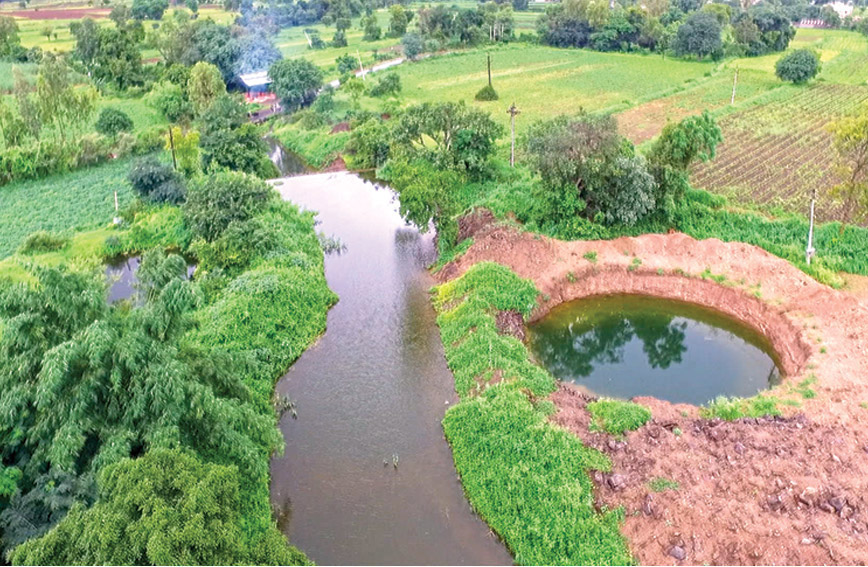 Results of last year's work: a shimmering stream and a pond brimming with water
Results of last year's work: a shimmering stream and a pond brimming with water
The Paani Foundation arms the representatives with solid technical resources. The Watershed Organisation Trust (WOTR), based in Ahmednagar, is Paani Foundation’s knowledge partner. WOTR has trained 40 Panlot Sevaks — barefoot watershed technicians — to provide field guidance to the foundation.
Three technical trainers are stationed in each taluk. After last year’s competition, the Paani Foundation called for applications for the job of technical trainer. Out of 200 applicants, it selected 40.
Alongside, the Paani Foundation has produced over 130 educational videos on different soil and water structures, success stories, discussions and a fiction series on water. Its water heroes series has 25 inspiring success stories in Hindi and Marathi.
Villagers can see some of these videos by downloading Paani Foundation’s app. During training, the five representatives are taught how to upload photos and file daily reports via the app.
Villagers can also ask Dr Pol for advice. He attends gram sabha meetings and interacts with thousands of villagers via satellite. During each episode a film or theatre personality joins the doctor. A caravan from village to village facilitates this online gram sabha. Aamir and Kiran take keen interest and visit villages from time to time.
Shramdaan is what brings people together. Once technical plans have been worked out, people voluntarily offer their labour. To avoid the scorching sun, shramdaan starts early in the morning. Volunteers do their quota of work and leave. But Paani Foundation’s dedicated workers continue. They plan the next day’s work, mark contour lines and send a report to the foundation’s office for approval.
Forty-five days’ shramdaan doesn’t magically create the watershed and soil conservation work every village requires. Invariably, earth diggers have to be hired to dig deep continuous contour trenches, ponds and so on. The village can raise resources from government programmes such as MGNREGA, IWMP (Integrated Watershed Management Programme), trusts or individual donors.
“Shramdaan is a strategy to bring people together,” says Dr Pol. “Unless the community is united, you can’t do this task effectively. The competition is very transparent. The marks card is published on the website. But we emphasise quality, not just quantity.”
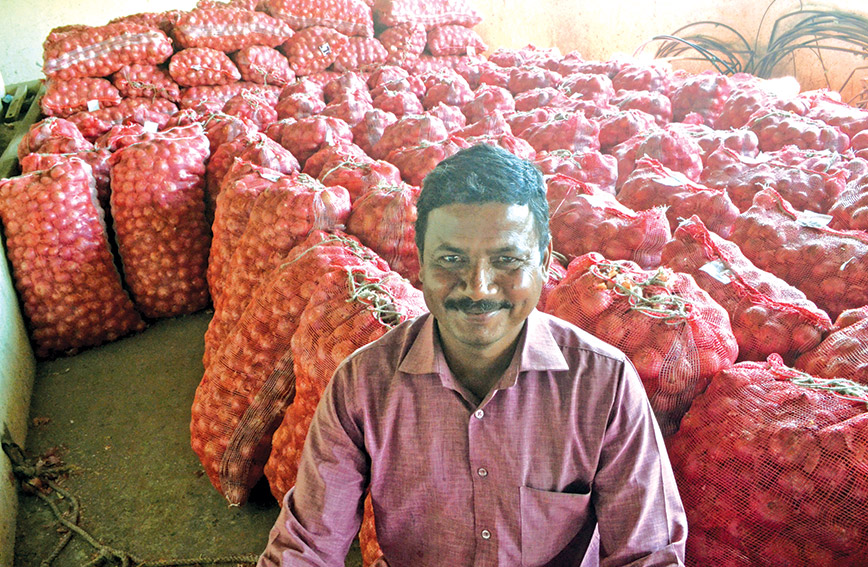 Shankar Rajaram Dhane of Bidal village with his onion crop
Shankar Rajaram Dhane of Bidal village with his onion crop
Village of onions
The revival of farms and villages depends on water. Take Bidal, the onion village in Satara district. For 17 years Bidal has been dependent on water tankers. The survival of its famed onion, the Pune Furusangi, is at stake.
Pune Furusangi is a tasty onion variety that can be stored for six months. About 10 onions make a kilo. Wholesale traders have settled in Bidal so that they can buy the Furusangi and sell it all over India.
Spread over 2,468 hectares, Bidal has a population of 5,974 and no water. The farmers here are hard-working and if they have water they produce a record crop. One example cited is of a 38-year-old farmer, Bapurao Jagadale. He has 10 acres. Three years ago he grew onion all over his land and harvested 20 tonnes. That year, onion prices hit the roof. Jagadale earned a good profit.
Bidal has 375 open wells. Due to persistent drought, farmers have been abandoning half-grown crops in their fields. Outside every house there is a drum for storing water from tankers. Each family is rationed 40 litres per day. Water is used very judiciously. Bath water flowing from the bathroom is collected in a basin and used for washing clothes.
“This year our tanker dependency began as early as January,” says 50-year-old Vilas Jagadale, a farmer. The village generally gets its quota of rain in September, a phenomenon that locals call ‘return rains’.
After joining the competition for the Satyamev Jayate Water Cup, a wave of enthusiasm has swept the village. Over half its residents have done their bit for making water harvesting structures. “We will finish two years’ work in 45 days. Then we will supply water to other villages,” says Appa Deshmukh, a farmer, optimistically.

Bidal has a historical precedent in social mobilisation. Around 50 years ago a bitter fight broke out during panchayat elections. Many were physically injured and many more psychologically.
The village elders felt regretful and took steps to end the bitterness. At a meeting held in the temple the entire village decided to select their panchayat members unanimously. This tradition is still followed. The village gathers at the temple before elections and selects members by consensus.
“We want to win this competition and we will,” says a government officer, requesting anonymity. He returns to Bidal every weekend and gets involved in planning. “When people here are working so hard and with so much harmony, how can I happily sleep in the city?” he asks.
He has explained the marks card to all the villagers and helped them set up committees to oversee the work.
Bidal came to know of a village called Satara Road which had taken part in last year’s water competition and built a range of soil and water conservation structures. An 80-member team from Bidal went on an exposure visit to study Satara Road’s structures.
“We have unity, we have money power, we lack motivation,” concluded the government officer after studying Satara Road. They put their heads together and came up with an idea.
Like Paani Foundation, Bidal too announced a competition. The basti that did the most voluntary labour and built the best structures would get the first prize of Rs 50,000. Those coming second and third would get Rs 30,000 and Rs 20,000. An additional prize of Rs 11,000 was for the basti doing the best overall work.
The idea has caught on. Another village has announced prizes for water works too: the first prize is a fridge, the second a mixie and the third a fan! Like Bidal, about a dozen villages have shown great enthusiasm and made substantial progress in the competition.
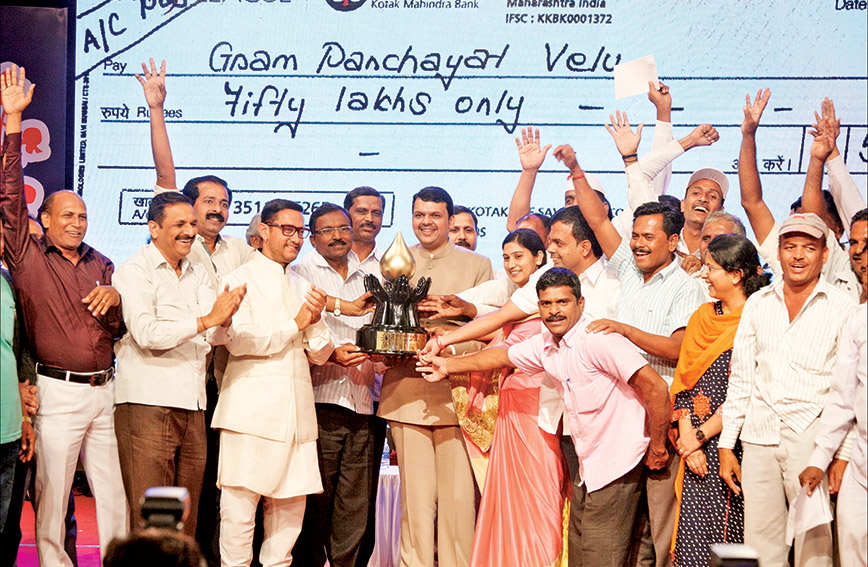 Devendra Fadnavis, Chief Minister of Maharashtra, and Aamir Khan at last year’s Satyamev Jayate Water Cup award ceremony. Velu village won the first prize.
Devendra Fadnavis, Chief Minister of Maharashtra, and Aamir Khan at last year’s Satyamev Jayate Water Cup award ceremony. Velu village won the first prize.
The people who join
The water movement has attracted diverse people: farmers, middle-class professionals, urban labour, the handicapped, government officials. At the grassroots, it is providing technical expertise that converts into jobs. Old disputes in villages are getting resolved as people come together.
Satara’s three taluks — Man, Khatav and Koregaon — are all starved of water. They get only 400 to 500 mm of rain. All the six villages I visited depended on tankers.
Nhavi Budruk is a tiny village in Khatav taluk, inhabited by 357 families. Voluntary labour has attracted around 1,000 people of all ages. “The number keeps rising day by day. When we began it wasn’t like this,” says Mohan Rao Laad, taluk coordinator.

Political parties, which want credit for work done, are the biggest obstacles to unity. The Paani Foundation has trained some local people as social coordinators to address such issues, but it is tough.
At Loni a few physically challenged persons have shown spirit and spunk. Namdev Dattu Kale, 73, lost his left leg in an accident decades ago. Yet he is a regular volunteer.
“You should see him working. While digging, he keeps his normal leg in the trench and the amputated one on the ground above. He does all the work able people do,” says Chandrakanth Phatdtare.
Subhash Sadashiv Shinde, 40, was born without the left half of his hand. He works in a cooperative bank in Mumbai. “We want to improve the lives of those who live here,” he says.
Pune and Mumbai are close to these villages. Water scarcity has forced people to head for the city. Around 100 painting contractors in Mumbai are from Kumthe in Khatav taluk. Bhosre has 700 families and most work for meagre salaries in Mumbai.
Kumthe has 147 open wells and 700 bore wells. For six years, water tankers have been doing the rounds. And since February, Kumthe gets water only on alternate days.
All the villages in Khatav taluk are raising funds. Kumthe has started a WhatsApp group. “Each family has contributed Rs 1,000 to the fund. We haven’t compelled anyone. Our people who have migrated are also contributing,” explains Dr Mandave Kundlik Shamrao of Kumthe. They collected Rs 3 lakh. A team from Kumthe was getting ready to visit Mumbai because there has been a lot of migration there.
“Painting is a job that doesn’t need much training. I am also a painting contractor. My grandfather took to this line of work. It was scarcity of water that drove us to Mumbai,” recalls 41-year-old Sandeep Mandave.
Sixty-year-old Bhimrao Baburao Phadatare, a well-known advocate, lives in Satara but returns to Kumthe every weekend with his wife, Bharathi, to participate in shramdaan.
“Both of us enjoy doing this for our village,” says Bharathi. Phadathare had erected a shamiana in front of their house. The couple offered a meal to shramdaan volunteers at noon. The villagers decided to do shramdaan for another two hours in the evening.
“In most villages, this is turning out to be a people’s movement. The rest won’t be difficult. If all villagers work hard for two to three years, we will not suffer water shortages for 50 years,” says Laad. He is excited to be part of many surprising developments. “The unity we are achieving is paving the way for solving very old disputes in some villages,” he says.
In Padali Station village there was a stalemate over construction of a road to the crematorium. The issue came up for discussion when the villagers had assembled for shramdaan. With a little effort by activists, the villagers who had been objecting to the road for years agreed to its construction and it was completed in three days.
Ankush Anna Mandave, a captain in the merchant navy, is from Kumthe village where his family owns agricultural land. Ankush earns very well from his job. But he is so attached to his village that he returns on weekends to work on the farm. He now takes part in shramdaan.
“I am used to manual work, so after three hours of shramdaan in the scorching sun, I don’t feel tired. Instead, I feel thrilled that I could work for my village. Forget me. You should see my 80-year-old mother, Savithribai, working with us,” he says.His wife, Meenakshi, and 10-year-old son, Ashwith, join him. He estimates it will take 10 years to reach the groundwater level his village used to have.
The movement has snowballed. On 1 May, Maharashtra Day, organisers appealed to people to take part in a special shramdaan and 17,000 people from all walks of life, unconnected with the competing villages, took part.
“This is the biggest people’s movement after independence,” says Amol Mandave, a young Assistant Commissioner of Police designate from Kumthe.
“The lessons I learnt during four days’ training at Paani Foundation are the most valuable in my life,” says Dayanand Nikam, a trainer at Navi Budruk. “If we fully practise what was taught to us, within three or four years we can attain the water table our forefathers enjoyed, provided there is good rainfall.”
Vishwas Gujar of Bhosare village is a tehsildar who works in Mumbai. He has taken 45 days’ leave to do shramdaan. He says 700 people have migrated to Mumbai from his village. “Once my village is drought-proofed, I think most migrants will return. They earn around Rs 200-300 per day working 10-12 hours a day and living in abysmal conditions. If they can peacefully cultivate their fields, why will they migrate?”
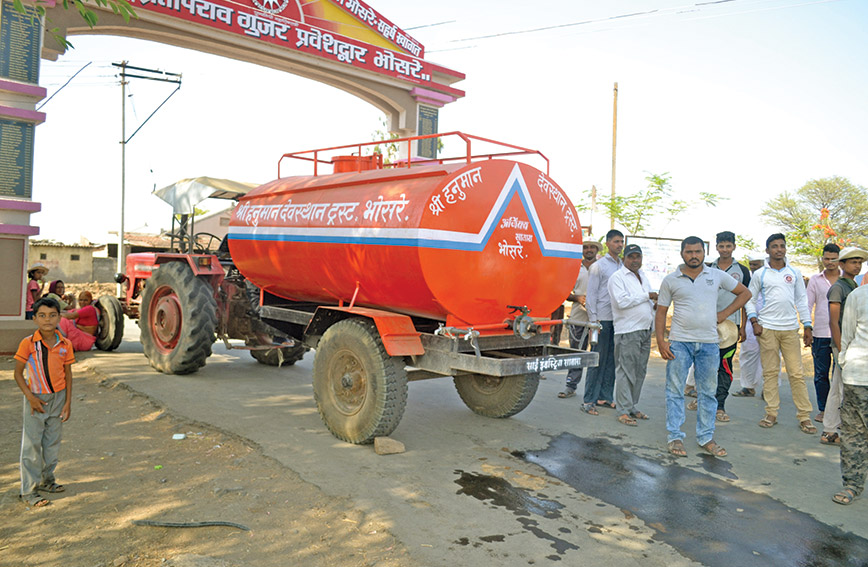 Villages have been depending on water tankers for decades
Villages have been depending on water tankers for decades
But not all villages are enthusiastic. “In my jurisdiction of six taluks, there are a few villages where work hasn’t started despite our best efforts. One reason is that there is a festival going on in some villages. In others there was a by-election and the scars of that fight are still fresh,” says Balasaheb Shinde, district coordinator.
The inspiring sparrow
Padsali village in North Solapur taluk is a typical case of lethargy. First, a five-member team trained by Paani Foundation backed out. Then, a second team was trained. The only one inspired by the idea was Vishnu Bhosale, a 45-year-old farmer. On the first day, he was the lone volunteer doing shramdaan. Bhosale tried getting other people interested but without much success. But he didn’t get discouraged. He carried on desilting a pond with determination. Two old men joined him after a few days.
News reached Aamir. Without making any arrangements, he, Kiran and Dr Pol arrived at the percolation pond where Bhosale and the two elderly men were digging away. “I am impressed by Vishnubhai’s determination,” said Aamir. “I too want to follow in his footsteps.” Aamir then dug soil for half an hour till the tractor trailer was full. The video crew was called and they produced a short success story in Marathi titled, How a villager from Solapur waged a war against drought. The latest news is that 22 volunteers have joined Bhosale.
What made Bhosale battle all alone? A story narrated while he was training with Paani Foundation, inspired him deeply. Here’s the story:
A huge fire engulfs a forest. Many animals get charred inside. Neither the elephant, the cheetah, the lion or even humans on the other side of the jungle do anything to extinguish the fire. A sparrow flying above sees the raging fire and notes the pathetic state of the animals. The sparrow plunges into a pond nearby, flies to where the fire is and drops a few driblets of water. The bigger animals ridicule the sparrow. “How can your drops of water put out the fire?” they laugh. “Yes, I know the reality. My efforts can’t. But when the history of this tragedy is written, my name will be listed under doers. And yours as dumb spectators,” replies the sparrow.
A new lexicon
Several factors make Paani Foundation’s work strikingly unique. First, it believes staunchly in community-based development and has designed programmes accordingly. Right knowledge and right action are motivating people. This knowledge, explained in simple terms, is understood and disseminated from village to village.
Second, the foundation’s strategy of empowering stakeholders with knowledge and motivation is more result-oriented than the subsidy and sops approach to development. It is likely to raise a non-political rural leadership that is badly needed. Such opportunities don’t exist in the subsidy-sops system.
“Watershed development is continuous work. We can’t say that all villages will work enthusiastically. The percentage of work that is completed depends on their unity and tempo,” says Dr Pol. “The main difference in our work is that, unlike the government or the NGO sector, we aren’t giving a single rupee to the villagers. Given the right chance, we believe our villagers can do their work by themselves.”
“This is a movement from below,” says Satyajit Bhatkal, CEO of the Paani Foundation. “If you motivate and give knowledge to people and they decide to change, that becomes so powerful that no one can hold them back. After reviewing this year’s performance, we will scale up. Our single vision is to create a drought-proof Maharashtra.”
“This is an interesting experiment,” says Crispino Lobo, Managing Trustee of WOTR. “See the timing of the programme. It just precedes the monsoon. Once the rains shower the earth, the hope in the hearts of communities will turn into conviction. That itself will be motivation to carry out the rest of the work.”
Scores of dedicated local people have joined the movement: Balasaheb as technical trainer, Surekha Phadke as social trainer, Bharathi Phadke as village trainer and so on. “Talk to them for 15 minutes, it will be difficult for you to believe they are not engineers,” says Dr Pol.
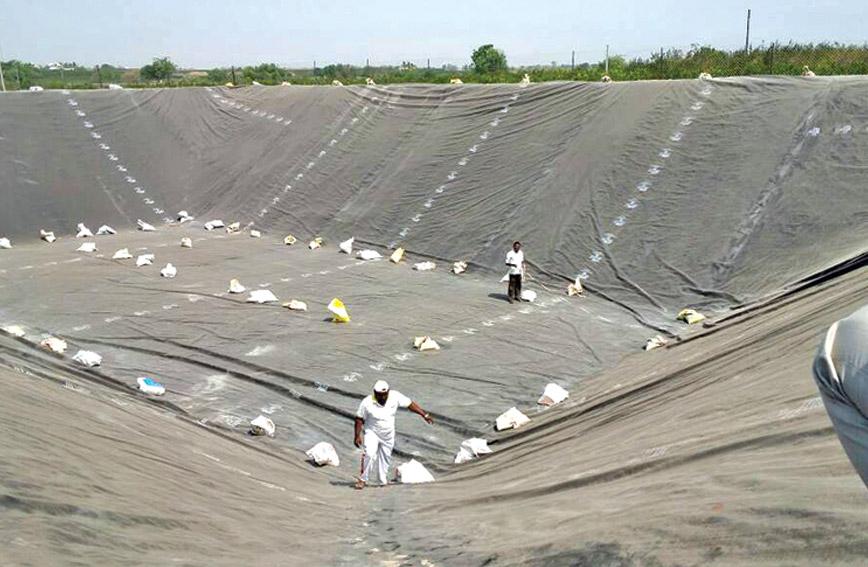 A tank being readied for the monsoon
A tank being readied for the monsoon
Comments
-

Farin Mushtaq Kable - April 6, 2020, 8:01 p.m.
Great achievement
-

Dr Smita Jinturkar - April 12, 2019, 6:18 a.m.
This work is amazing, this year my village Wadali, Taluka Jintur Dist Parbhani is the participant . I am physically and emotionally involved in the competition. Whether we win WATER CUP or not doen't matter to me but I want to see water in everybody's cup. HATS OFF TO YOU ALL
-

Dr. Ravi Kant Dev Saxena - April 6, 2019, 12:12 p.m.
I was preparing for a lecture on "Role of NGO in Social Transformation. I was thrilled to see the results achieved by "Paani Foundation". My Best wishes for your initiative. May god bless your team.
-

Upendra Dhonde - Aug. 1, 2018, 11:02 a.m.
Your story on the work of the Paani Foundation, ‘Winning the Water Cup,’ had detailed information. I would request you to update the current status of this important project. It takes time to assess the results of a water campaign. Data from the past few years, current status and future evaluation pattern must be evaluated.
-

Anand - July 1, 2018, 12:34 a.m.
Gr8 work ! I am following up for last 6 months. Look forward to actively engage next year.
-

Sagar Bhosale - June 26, 2018, 2:48 p.m.
We all need to take this as learning , this is the best example of people movement ..Such more initiatives can build our nation stronger and vibrant ... Water Flooding occurs when an extreme volume of water is carried by rivers, creeks and many other geographical features into areas where the water cannot be stored or stopped ..But we can divert the water towards near by Drought Area.. thank you all the Hard Work and great initiative..
-

kiran s. bhanushali - June 9, 2018, 7:21 a.m.
very impressive work done . till many acheivements balance , support required ,tendency of villagers to change & look for progress........hats of you
-

subhash abhyankar - June 8, 2018, 12:33 p.m.
Very nice work, i would like to work with villagers, Water Cup.
-

N Deshmukh - May 17, 2018, 12:04 a.m.
Very nice initiative, one of a kind since independence struggle probably. Could this team publish the learning that helped them improvise the whole process Also would like to see efforts taken by teams within Paani Foundation organization to lead this venture into success Jai Maharashtra
-

sajid shah - Feb. 4, 2018, 8:19 p.m.
Excellent
-

Dayanand Madane - July 16, 2017, 7:30 a.m.
Jagdale farmer from Bidal village average yield of onion 20 ton per acre In 10 acre area means total 200 ton production Spirit of Bidal , Hats of Bidal people for its work in satymev jayate water cup Its History of records in drougt prone area of Man Tahsil of Maharashtra ...they came together & brings history , Most of people participate in all 45 days for shramdan ..again salute to all pani foundation team for this revolu did
-

Janardan pandurang jagadale - July 14, 2017, 11:10 p.m.
It's really unbelivable work done by farmers and his family through pani foundation. I am proud of village bidal they did really good job by all bidalkar. In maharashtra one day will make history by making entire maharashtra will be panidar.
-

Pravin ingale - July 14, 2017, 2:43 p.m.
Well inspiration given to people for team work and output of teamwork .....I m salute the panni foundation work
-

Harish B S - June 9, 2017, 8:42 p.m.
Amazing story, beautifully expressed and articulated, motivational too. Thanks to Padre Sir and, of course, to the Paani Foundation. Truly inspirational.
-

MM Sharma - June 3, 2017, 9:16 p.m.
Congratulations. Bahut bahut badhai. Aapka kaam shaandar hai. Iska prabhav eak dooo saal nahin, sau saal tak fayada karega. Meri bahut shubkamanae.
-

VIJAY KEDIA - June 3, 2017, 11:35 a.m.
"He ( Jagdale) has 10 acres. Three years ago he grew onion all over his land and harvested 20 tonnes. That year, onion prices hit the roof. Jagadale earned Rs 1 crore from his onions." Pl check the figures again: a) Rs 1 core Earning in 10 acre means Rs 10 lakh per acre !!!!!!! b) Rs 1 crore for 20 Ton onions means Rs 500 per Kg. Request you to please cross check figures before publishing . bcoz people simply sees Your Published amount in crores of rupees.
-

VIJAY KEDIA - June 3, 2017, 11:24 a.m.
"a billion litres of water, which would otherwise have arrived in 1.3 million tanker loads. And Rs 272 crore worth " Some calculation correction needed: a) 1 billion ltr water saved is 100 crore ltr. That will be 0.1 million Tankers ( of 10, 000 ltr) . Not 1.3 million b) Saving of Rs 272 Crore means cost of water to be Rs 2.72 per ltr . i.e. Rs 27,000 rs per tanker Something amiss somewhere ?
-

Sudarshan Jain - June 3, 2017, 9:24 a.m.
Really real social work has been done for Maharashtra.



